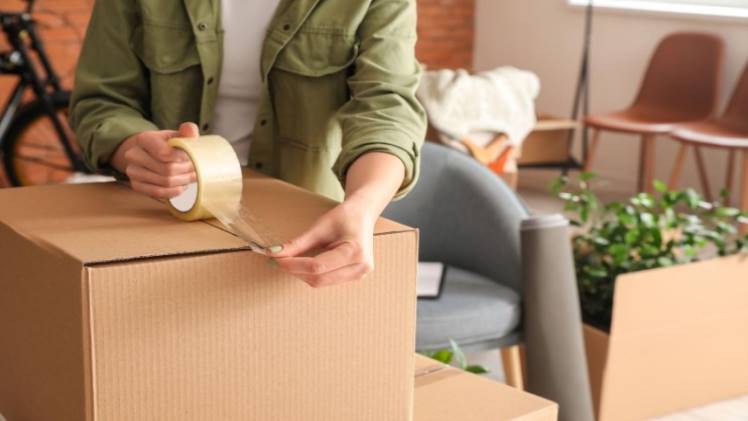Top 5 Packing Mistakes to Avoid When Moving Interstate

Moving interstate is an exciting opportunity to start fresh in a new location. However, the process of packing can be a tricky task.
To ensure a smooth and stress-free move, it’s important to be aware of common packing mistakes that can lead to damaged belongings, lost items, and unnecessary headaches.
In this comprehensive guide, we will highlight the top 10 packing mistakes to avoid when moving interstate.
By learning from these mistakes and implementing the suggested solutions, you’ll be able to protect your belongings and be well-prepared for a successful and organised move. Let’s dive in!
Procrastinating Packing
One of the biggest mistakes is leaving packing until the last minute. Procrastination leads to rushed packing, poor organisation, and added stress. Start early and create a packing schedule to tackle one room at a time.
Begin with items you use less frequently and gradually work your way to daily essentials.
How to Avoid Procrastinating Packing?
- Create a Packing Schedule: Break down the packing process into manageable tasks by creating a schedule. Set specific deadlines for each room or category of items to keep yourself accountable and on track.
- Start Early: Begin packing as soon as you know you’re moving interstate. Even if it’s just a few boxes a day, the earlier you start, the more time you’ll have to pack everything systematically.
- Prioritise Less Frequently Used Items: Begin packing items that you use less frequently or won’t need until after the move. This includes seasonal clothing, books, decorative items, and non-essential kitchenware. By tackling these items first, you’ll feel a sense of progress and reduce clutter in your current living space.
- Break It Down: Instead of viewing packing as a massive, overwhelming task, break it down into smaller, more manageable tasks. Focus on one room or category of items at a time, and complete each before moving on to the next. This approach will make packing feel less daunting and more achievable.
- Seek Help: Don’t be afraid to ask friends, family, or professional packers for assistance. Having extra hands on deck can significantly speed up the packing process and provide you with much-needed support and motivation.
- Set Daily or Weekly Goals: Establish realistic packing goals for yourself. For example, commit to packing a certain number of boxes each day or dedicate specific hours each week to packing. Having measurable goals will help you stay on track and maintain a consistent pace.
- Stay Organised: Keep your packing supplies, such as boxes, tape, markers, and bubble wrap, readily available and organised in one central location. This way, you won’t waste time searching for materials when you’re ready to pack.
- Celebrate Milestones: Reward yourself when you achieve packing milestones. This could be treating yourself to a favorite snack, taking a break to enjoy a movie, or simply acknowledging and appreciating your progress. Celebrating small victories will keep you motivated and energised throughout the packing process.
Not Decluttering Before Packing
Bringing unnecessary items to your new home only adds to the clutter and cost. Before packing, take the time to declutter and get rid of items you no longer need or use. Donate, sell, or discard unwanted belongings to lighten your load and make packing more efficient.
Top 8 Tips For Decluttering:
- Plan Ahead: Before you start packing, allocate dedicated time to decluttering. Set aside specific days or weekends to focus solely on sorting through your belongings and making decisions about what to keep, donate, sell, or discard.
- Take it Room by Room: Begin decluttering one room at a time. This helps to break down the task into more manageable chunks, making the process less overwhelming. Start with areas that tend to accumulate the most clutter, such as closets, basements, or storage rooms.
- Sort Items into Categories: Create categories for your belongings, such as “keep,” “donate,” “sell,” and “discard.” As you go through each item, make a conscious decision about which category it belongs to. This will help you stay organised and focused during the decluttering process.
- Consider the 80/20 Rule: The 80/20 rule suggests that we only use about 20% of our belongings regularly. Keep this in mind when deciding what to keep. Ask yourself if you have used or needed the item within the past year. If not, consider parting with it.
- Use the Four-Box Method: As you declutter, use the four-box method to streamline the process. Label four boxes or bins as “keep,” “donate,” “sell,” and “discard.” Place each item in the corresponding box as you make decisions, making it easier to sort and categorise your belongings.
- Donate or Sell Unwanted Items: Consider donating items in good condition to local charities or organisations in need. Alternatively, sell items that still have value through garage sales, online marketplaces, or consignment stores. This not only reduces clutter but also benefits others and potentially puts some extra money in your pocket.
- Dispose of Unusable Items: Properly dispose of items that are broken, damaged, or beyond repair. Recycle or throw away these items responsibly to free up space and avoid unnecessary clutter in your new home.
- Visualise Your New Space: Envision your new home and how you want it to look and feel. This can serve as motivation to declutter and only keep the items that align with your vision. Visualising your ideal living environment can make the decision-making process easier.
Using Unsuitable or Insufficient Packing Materials
Using inadequate or low-quality packing materials can result in damaged items during transit. Invest in sturdy boxes, bubble wrap, packing paper, and packing tape to protect your belongings properly. Fragile items require extra padding and care, so don’t skimp on protective materials.
Solutions to overcome using unsuitable packing materials
Assess Your Packing Needs: Before you start packing, evaluate the types of items you’ll be transporting. Determine whether you’ll need specialised packing materials for fragile items, such as bubble wrap, packing peanuts, or foam inserts. Understanding your packing requirements will help you select the appropriate materials.
Invest in Quality Packing Supplies: Purchase high-quality packing materials that are specifically designed for moving. Look for sturdy boxes in various sizes, packing tape, bubble wrap, packing paper, and furniture blankets. Investing in quality supplies ensures better protection for your belongings during transit.
Use Appropriate Box Sizes: Match the size of the box to the items you’ll be packing. Heavy items should be placed in smaller boxes to avoid overloading and potential breakage. Lighter items can be packed in larger boxes. This helps maintain the integrity of the boxes and minimises the risk of damage.
Cushion Fragile Items: Fragile items require extra protection during transit. Wrap them individually with bubble wrap or packing paper to create a cushioning layer. Place them in appropriately sized boxes with additional padding on the bottom and sides. This will help absorb shocks and reduce the risk of damage.
Label Fragile Boxes: Clearly label boxes containing fragile items as “Fragile” or “Handle with Care.” This alerts movers to exercise caution when handling these boxes. Additionally, mark which side of the box should be kept upright to avoid any mishandling during transportation.
Utilise Blankets and Towels: Instead of solely relying on packing materials, make use of blankets, towels, and linens to provide extra padding for delicate or breakable items. Wrap them around sensitive surfaces or place them between items to prevent scratching or impact damage.
Fill Empty Spaces: Prevent items from shifting inside the boxes by filling empty spaces with packing paper, bubble wrap, or clothing. This helps secure the items in place, minimising movement and reducing the risk of damage.
Use Proper Sealing Techniques: Ensure that all boxes are properly sealed with packing tape. Reinforce the bottom and edges of the boxes to prevent them from collapsing or opening during transit. This adds stability and ensures the contents are well-protected.
Overpacking Boxes
Stuffing boxes to the brim may seem efficient, but it can lead to boxes becoming too heavy or prone to damage.
Avoid overpacking by distributing items evenly and keeping the weight manageable. Use smaller boxes for heavier items and larger boxes for lighter belongings.
How to Avoid Overpacking Boxes?
- Use Appropriate Box Sizes: Select boxes of various sizes based on the weight and size of the items you’re packing. Heavy items should go in smaller boxes, while lighter items can be packed in larger boxes. This ensures that the boxes remain manageable and not excessively heavy.
- Follow Weight Guidelines: Pay attention to weight guidelines provided by the box manufacturer or moving company. These guidelines help prevent boxes from becoming too heavy, which can lead to structural damage or injury during lifting and transportation.
- Fill Empty Space with Packing Material: Fill any empty space within the box with packing material, such as bubble wrap, packing peanuts, or crumpled paper. This helps prevent items from shifting and keeps them securely in place. It also provides extra cushioning and protection.
- Reinforce Bottom and Corners: Strengthen the bottom and corners of the box by using additional packing tape. This helps maintain the structural integrity of the box, especially when it contains heavy or fragile items.
- Label Boxes with Weight Limits: Clearly mark the weight limit on each box to indicate its maximum load capacity. This serves as a reminder to avoid overpacking and ensures that the box is handled appropriately during the moving process.
- Distribute Weight Evenly: When packing a box, distribute the weight evenly throughout. Place heavier items at the bottom and lighter items on top. This helps maintain balance and stability, preventing the box from becoming too top-heavy or bottom-heavy.
- Consider Special Handling for Fragile Items: Fragile items require extra care and protection. Consider packing them separately in smaller, properly padded boxes to ensure they receive the necessary cushioning and support. Avoid overpacking fragile items with other heavy or bulky items that may cause damage.
- Don’t Fill Beyond the Top Flap: As a general rule, avoid packing items beyond the top flap of the box. This allows for easy closure and ensures that the box can be securely sealed without items protruding or causing strain on the box.
Failing to Label Boxes
Skipping the labeling process can turn unpacking into a chaotic endeavor. Clearly label each box with its contents and the room it belongs to. This will save you time and frustration when unpacking in your new home. Make sure to label fragile items appropriately for careful handling.
Tips to Label Boxes Properly
Use Clear and Descriptive Labels: Clearly label each box with a brief description of its contents. Be specific and detailed when labeling, mentioning the room the items belong to and any notable details about the contents. This will make it easier to locate specific items when unpacking.
Color-Code the Labels: Assign a specific color to each room or category of items. Use colored labels or colored markers to indicate which room the box should be placed in. This visual cue makes it quick and easy to identify where each box belongs.
Create an Inventory List: Maintain a detailed inventory list that corresponds to the labeled boxes. Note down the box number, its contents, and any other relevant details. This will serve as a reference during the unpacking process and help you keep track of your belongings.
Utilise a Labeling System: Develop a consistent labeling system that works for you. You can use numbered labels, alphabetical labels, or a combination of both. Make sure to record the labeling system you’ve chosen so that you can easily decipher it when unpacking.
Label Fragile Items Appropriately: If a box contains fragile items, clearly mark it with a “Fragile” or “Handle with Care” label. This alerts movers to exercise caution when handling the box and ensures fragile items receive the necessary care during transit.
Place Labels on Multiple Sides: Apply labels to multiple sides of each box. This ensures that the labels remain visible, regardless of how the boxes are stacked or stored. It makes it easier to identify the contents without having to rotate or move boxes around.
Keep a Master List: Maintain a master list or digital document that records the contents of each labeled box. This will serve as an additional reference point and make it easier to search for specific items without having to physically open each box.
Label Unpacking Priority: Consider using labels to indicate the priority level for unpacking each box. Use terms like “High Priority,” “Medium Priority,” or “Low Priority” to guide your unpacking process and help you focus on the most essential items first.
Conclusion:
By avoiding these top 5 packing mistakes, you’ll be well-prepared for a successful interstate move. Start early, declutter, use proper packing materials, label boxes clearly, and create an inventory to stay organised throughout the process.
Taking these precautions will save you time, protect your belongings, and make the unpacking process much smoother in your new home. Remember, a well-packed move sets the foundation for an enjoyable and stress-free transition to your new interstate location.
Moving Interstate From Sydney?
By enlisting the help of reputable professionals like the Interstate Removalist in Sydney, you can have complete confidence that your valuable possessions will be handled with the utmost care and precision.
With their extensive experience, you can trust that your items will be treated safely and receive the attention they deserve, granting you peace of mind throughout the entirety of your move.





